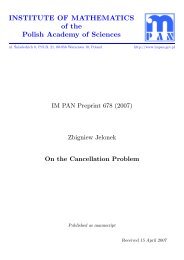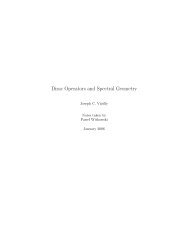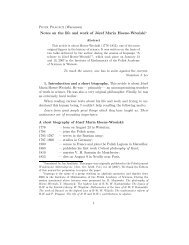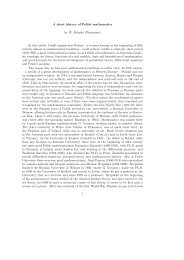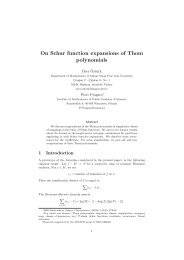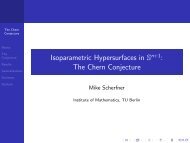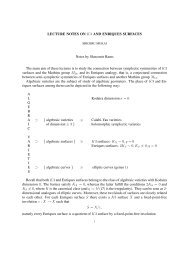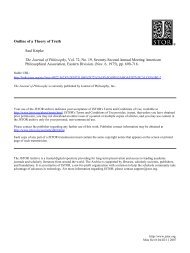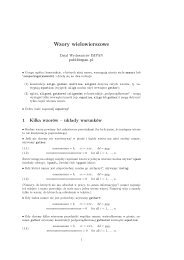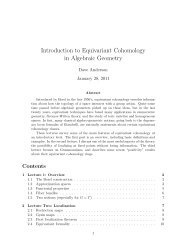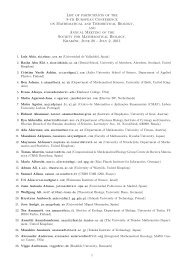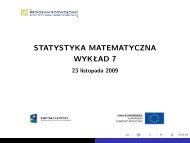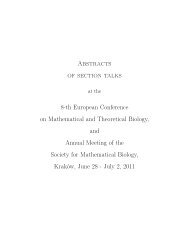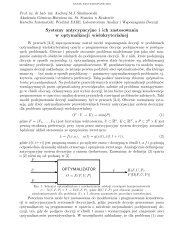Abstracts of Posters 8-th European Conference on Mathematical ...
Abstracts of Posters 8-th European Conference on Mathematical ...
Abstracts of Posters 8-th European Conference on Mathematical ...
Create successful ePaper yourself
Turn your PDF publications into a flip-book with our unique Google optimized e-Paper software.
<str<strong>on</strong>g>European</str<strong>on</strong>g> <str<strong>on</strong>g>C<strong>on</strong>ference</str<strong>on</strong>g> <strong>on</strong> Ma<str<strong>on</strong>g>th</str<strong>on</strong>g>ematical and Theoretical Biology 2011<br />
Ma<str<strong>on</strong>g>th</str<strong>on</strong>g>ematical Modeling <str<strong>on</strong>g>of</str<strong>on</strong>g> Mosquito-Borne Diseases; Tuesday, June 28, 11:00<br />
Angelina Mageni Lutambi 1,2<br />
e-mail: angelina-m.lutambi@unibas.ch<br />
Nakul Chitnis 1<br />
Melissa Penny 1<br />
Tom Smi<str<strong>on</strong>g>th</str<strong>on</strong>g> 1<br />
1 Swiss Tropical and Public Heal<str<strong>on</strong>g>th</str<strong>on</strong>g> Institute, Socinstrasse 574002 BASEL,<br />
Switzerland<br />
2 Data Analysis Cluster, Ifakara Heal<str<strong>on</strong>g>th</str<strong>on</strong>g> Institute, Coordinati<strong>on</strong> <str<strong>on</strong>g>of</str<strong>on</strong>g>fice,<br />
Kiko Avenue, Mikocheni, PO Box 78373, Dar es Salaam, Tanzania<br />
Modelling mosquito dispersal in a heterogeneous<br />
envir<strong>on</strong>ment<br />
Mosquito foraging behaviour for hosts and ovipositi<strong>on</strong> sites/habitats is an important<br />
aspect for malaria c<strong>on</strong>trol. Recent studies have highlighted <str<strong>on</strong>g>th</str<strong>on</strong>g>e impact <str<strong>on</strong>g>of</str<strong>on</strong>g><br />
<str<strong>on</strong>g>th</str<strong>on</strong>g>e presence <str<strong>on</strong>g>of</str<strong>on</strong>g> habitats <strong>on</strong> mosquito search for ovipositi<strong>on</strong> sites. While o<str<strong>on</strong>g>th</str<strong>on</strong>g>ers have<br />
highlighted <str<strong>on</strong>g>th</str<strong>on</strong>g>e significance <str<strong>on</strong>g>of</str<strong>on</strong>g> habitat eliminati<strong>on</strong> wi<str<strong>on</strong>g>th</str<strong>on</strong>g>in certain distances from human<br />
habitati<strong>on</strong>s to prevent mosquitoes using human hosts for blood meals. While<br />
minimizing or eliminating <str<strong>on</strong>g>th</str<strong>on</strong>g>e impact <str<strong>on</strong>g>of</str<strong>on</strong>g> mosquitoes <strong>on</strong> <str<strong>on</strong>g>th</str<strong>on</strong>g>e spread <str<strong>on</strong>g>of</str<strong>on</strong>g> malaria has<br />
been a c<strong>on</strong>cern <str<strong>on</strong>g>of</str<strong>on</strong>g> current malaria research, mosquito dynamics and mosquito spatial<br />
distributi<strong>on</strong> remain a challenge. The goal <str<strong>on</strong>g>of</str<strong>on</strong>g> <str<strong>on</strong>g>th</str<strong>on</strong>g>is work is to describe and understand<br />
mosquito populati<strong>on</strong> dynamics in relati<strong>on</strong> to dispersal in spatial envir<strong>on</strong>ments.<br />
A simple ma<str<strong>on</strong>g>th</str<strong>on</strong>g>ematical model based <strong>on</strong> <str<strong>on</strong>g>th</str<strong>on</strong>g>e mosquito life cycle is formulated<br />
to describe <str<strong>on</strong>g>th</str<strong>on</strong>g>e populati<strong>on</strong> dynamics <str<strong>on</strong>g>of</str<strong>on</strong>g> mosquitoes. Dispersal <str<strong>on</strong>g>of</str<strong>on</strong>g> adult mosquitoes<br />
searching ei<str<strong>on</strong>g>th</str<strong>on</strong>g>er for hosts or ovipositi<strong>on</strong> sites is also modelled and its effects incorporated<br />
in <str<strong>on</strong>g>th</str<strong>on</strong>g>e populati<strong>on</strong> dynamics. The spatial aspect <str<strong>on</strong>g>of</str<strong>on</strong>g> mosquito dispersal is<br />
described by <str<strong>on</strong>g>th</str<strong>on</strong>g>eir movement between patches in a two-dimensi<strong>on</strong>al spatial envir<strong>on</strong>ment.<br />
A hexag<strong>on</strong>al grid wi<str<strong>on</strong>g>th</str<strong>on</strong>g> each hexag<strong>on</strong> representing a patch is used where<br />
vital dynamics are allowed to occur. Numerical simulati<strong>on</strong>s are carried out to<br />
dem<strong>on</strong>strate <str<strong>on</strong>g>th</str<strong>on</strong>g>e biological applicati<strong>on</strong> <str<strong>on</strong>g>of</str<strong>on</strong>g> <str<strong>on</strong>g>th</str<strong>on</strong>g>e model.<br />
The modelled populati<strong>on</strong> dynamics <str<strong>on</strong>g>of</str<strong>on</strong>g> each stage <str<strong>on</strong>g>of</str<strong>on</strong>g> <str<strong>on</strong>g>th</str<strong>on</strong>g>e mosquito life cycle in<br />
space are presented and <str<strong>on</strong>g>th</str<strong>on</strong>g>e links between factors influencing <str<strong>on</strong>g>th</str<strong>on</strong>g>e spatial dynamics<br />
are discussed.<br />
602



